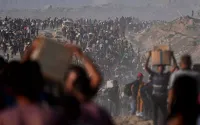23 July 2006
Deep in the heart of the world's greatest rainforest, nine days' journey by boat from the sea, Otavio Luz Castello is anxiously watching the soft waters of the Amazon drain away. Every day they recede further, like water running slowly out of an unimaginably immense bath, threatening a global catastrophe.
He pointed out what was happening on Wednesday, standing on an island in a quiet channel of the giant river. Just a month ago, he explained, it had been entirely under water. Now it was jutting a full 15 feet above it.
It is a sign that severe drought is returning to the Amazon for a second successive year. And that would be ominous indeed. For, as we report on page 12 today, new research suggests that just one further dry year beyond that could tip the whole vast forest into a cycle of destruction.
Just the day before, top scientists had been delivering much the same message at a remarkable floating symposium on the Rio Negro, on whose strange black waters this capital city of the Amazon stands. They told the meeting - convened on a flotilla of boats by Ecumenical Patriarch Bartholomew of the Greek Orthodox Church, dubbed the "green Pope" for his environmental activism - that global warming and deforestation were rapidly pushing the entire enormous area towards a "tipping point", where it would irreversibly start to die.
The consequences would be truly awesome. The wet Amazon, the planet's greatest celebration of life, would turn to dry savannah at best, desert at worst. This would cause much of the world - including Europe - to become hotter and drier, making this sweltering summer a mild foretaste of what is to come. In the longer term, it could make global warming spiral out of control, eventually making the world uninhabitable.
Nowhere could seem further from the world's problems than the idyllic spot where Otavio Luz Castello lives. The young naturalist's home is a chain of floating thatched cottages that make up a research station in the Mamiraua Reserve, halfway between here and Brazil's border with Colombia.
Rare pink river dolphin play in the tranquil waters surrounding the cottages, kingfishers dive into them, giant, bright butterflies zig-zag across them and squirrel monkeys romp in the trees on their banks. And an 18ft black caiman answers, literally, to the name of Fred; gliding up to dine abstemiously on sliced white bread when called. There is little to suggest that it may be witnessing the first scenes of an apocalypse. The waters of the rivers of the Amazon Basin routinely fall by some 30-40 feet- greater than most of the tides of the world's seas - between the wet and dry seasons. But last year they just went on falling in the worst drought in recorded history.
In the Mamiraua Reserve they dropped 51 feet, 15 feet below the usual low level and other areas were more badly affected. At one point in the western Brazilian state of Acre, the world's biggest river shrank so far that it was possible to walk across it. Millions of fish died; thousands of communities, whose only transport was by water, were stranded. And the drying forest caught fire; at one point in September, satellite images spotted 73,000 separate blazes in the basin.
This year, says Otavio Luz Castello, the water is draining away even faster than the last one - and there are still more than three months of the dry season to go. He adds: "I am very concerned."
It is much the same all over Amazonia. In the Jau National Park, 18 hours by boat up the Rio Negro from here, local people who took me out by canoe at dawn found it impossible to get to places they had reached without trouble just the evening before. Acre, extraordinarily, received no rain for 40 days recently, and sandbanks are already beginning to surface in its rivers. Flying over the forest - with trees in a thousand shades of green stretching, for hour after hour, as far as the eye can see - it seems inconceivable that anything could endanger its verdant immensity. Until recently, scientists took the same view, seeing it as one of the world's most stable environments.
Though they condemned the way that, on average, an area roughly the size of Wales is cut down each year, this did not seem to endanger the forest as a whole, much less the entire planet. Now they are changing their minds in the face of increasing evidence that the deforestation is pushing both the Amazon and the world to the brink of disaster.
Dr Antonio Nobre, of Brazil's National Institute of Amazonian Research, told the floating symposium - whose delegates ranged from politicians and environmentalists, to Amazonian Indian shamans and Roman Catholic cardinals - of unpublished research which suggests that the felling is both drying up the entire forest and helping to cause the hurricanes that have been battering the United States and the Caribbean.
The hot, wet Amazon, he explained, normally evaporates vast amounts of water, which rise high into the air as if in an invisible chimney. This draws in the wet north-East trade winds, which have picked up moisture from the Atlantic. This in turn controls the temperature of the ocean; as the trade winds pick up the moisture, the warm water that is left gets saltier and sinks.
Deforestation disrupts the cycle by weakening the Amazonian evaporation which drives the whole process. One result is that the hot water in the Atlantic stays on the surface and fuels the hurricanes. Another is that less moisture arrives on the trade winds, intensifying drought in the forest. "We believe there is a vicious cycle" says Dr Nobre.
Marina Silva, a fiery former rubber-tapper who is now Brazil's environment minister, described how the Government was finally cracking down on the felling by seizing illegally cut logs, closing down illicit enterprises and fining and imprisoning offenders. As a result, she says, it dropped by 31 per cent last year.
But even so, it has only returned to the levels it was in 2001, still double what it was 10 years before. And it has reached far into the forest after the American multinational Cargill built a huge port for soya three years ago at Santarem, some 400 miles downriver from here.
This encouraged entrepreneurs to cut down the trees to grow the soya.
The symposium flew down en masse to inspect the damage this had caused - vast fields of beans destined to feed supermarket chickens in Europe, where until recently there had been lush, trackless forest.
Priests and community leaders who were campaigning to protect the forest told us how they had received repeated death threats.
So far about a fifth of the Amazonian rainforest has been razed completely. Another 22 per cent has been harmed by logging, allowing the sun to penetrate to the forest floor drying it out. And if you add these two figures together, the total is growing perilously close to 50 per cent, which computer models predict as the "tipping point" that marks the death of the Amazon.
The models did not expect this to happen until 2050. But, says Dr Nobre, "what was predicted for 2050, may have begun to happen in 2005." Nobody knows when the crucial threshold will be passed, but growing numbers of scientists believe that it is coming ever closer.
One of Dr Nobre's colleagues, Dr Philip Fearnside, puts it this way: "With every tree that falls we increase the probability that the tipping point will arrive."
Brazilian politicians say that the country has so many other pressing problems that the destruction is unlikely to be brought under control, unless the world helps to pay for the survival of the forest on which it too depends. Calculations by Hylton Philipson, a British merchant banker and rainforest campaigner, reckon that it will take $60bn (£32bn) a year, less than a third of the cost of the Iraq war.
The scientists insist there is no time for delay. "If we do not act now", says Dr Fearnside, "we will lose the Amazon forest that helps sustain living conditions throughout the world."






